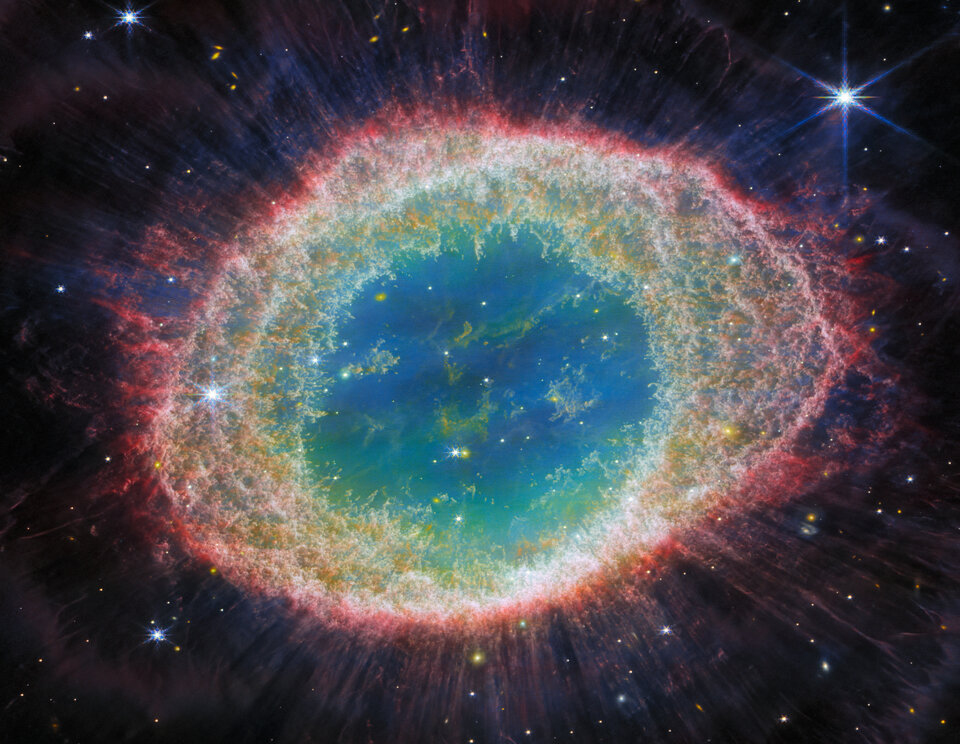I find it a little irritating that this APOD is so large that I have to post it here as an attachment!
The Nebulous Realm of WR 134. Image Credit & Copyright: Xin Long
What I really like about this image is that it doesn't just show us that bright and slightly tousled nebula at upper left, but we can also see the fainter, underlying, almost perfectly symmetrical nebulosity surrounding the star in a drafting-compass perfect circle!
Yet the rim of that circle isn't smooth, but divided into hundreds(?) of little nebular "fingers" all pointing at the central star. In fact, the rim of WR 124 is similar to the nebular rim of the Helix Nebula:
The most famous bubble nebula in the Milky Way is of course the Bubble Nebula. But the inner rim of the Bubble Nebula shows no signs of nebular fingers pointing at the central star.
We may note that, just as in WR 134, the Bubble Nebula is brightest at upper left. But, in contrast to WR 134, the hot star of the Bubble Nebula is not located at the center of its own nebula, but displaced far to the upper left.
What gives? The fact that both WR 134 and the Bubble Nebula are brighter in one spot is just due to the fact that the interstellar medium is thicker in that direction, and the outward-pushing nebula is "crashing harder" into the interstellar medium where the nebula is brighter. The "crash" leads to a stronger ionization and a brighter OIII emission.
But how do we explain the "fingers" of the nebular rim of WR 134, and the lack of such fingers in the Bubble Nebula?
The answer is probably the fact that WR 134 is indeed a Wolf-Rayet star. As such, it blows a tremendous wind, and it has bared deeper, hotter layers of itself, driving its temperature (in the case of WR 134) to 63,000 K. The central star of the Bubble Nebula, by contrast, is an O-type star of spectral class O6.5 and a temperature of 37,000 K, and while it is blowing a strong wind indeed, that wind is nothing compared with the wind of a Wolf-Rayet star.
You can see at top of nebula M1-67 surrounding WR 124 that the rim seems to show many little "fingers" pointing at the central star. Also note that the star is very centrally placed inside its own nebula. In the same way, a hot and windy young white dwarf can shape its nebular rim into the same kind of fingers as we see in WR 134.
My guess is that the Bubble Nebula is the product of a single major outburst of the central star. The star itself is not hot enough or windy enough to break up the outer nebular rim into little fingers. And since the nebular bubble is not being replenished, it is buffeted by outside forces into a shape where the central star is very much off-center.
By contrast, a Wolf-Rayet nebula is primarily shaped by the tremendous heat and wind of its own central star, so the star remains centrally placed in its own nebula, and the outer nebular rim is broken up into hundreds of little fingers.
Of course, in the case of WR 134, we see both the effects of outside buffeting (the bright "tousled hair" part of the nebula) and the effects of inside regulation (the perfectly circular rim of the nebula).
Ann
 The Nebulous Realm of WR 134
The Nebulous Realm of WR 134




